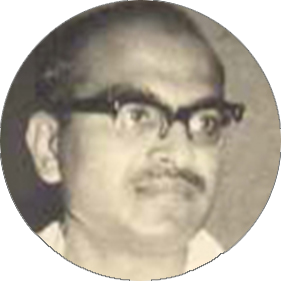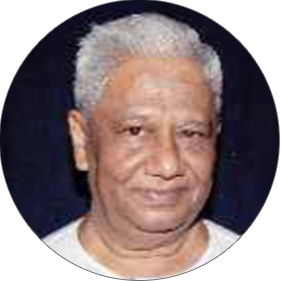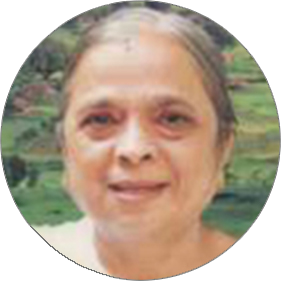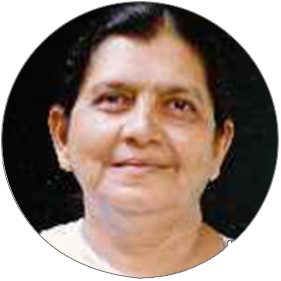Pillars of Sarvodaya Parivar Trust
The late founders of Sarvodaya Parivar, Dr. Navnintbhai, Kantaben, Harvilasben, and Kantibhai, were all originally from Mumbai. During the Bhoodan movement, Kantaben and Harvilasben responded to Vinobaji’s appeal and subsequently gave up their jobs, homes, and towns in 1957. Kantibhai joined Vinoba’s movement in 1960 and took on the responsibility of the publication of Bhoomiputra. Dr. Navnit Fozdar, a young MBBS doctor from Mumbai, was a member of Kantaben’s group.

Born in 1934, Navnitbhai received his MBBS degree in 1960. With the aim of extending the benefit of his medical services to the poorest needy people. Dr. Navnitbhai made Pindval the focus of his work.
The head of the the Pindval ashramshala, Manchhubhai warmly welcomed Dr. Navnitbhai. The Ashramshala building at that time consisted of two rooms and housed not only the school,but the kitchen, store and Navnitbhai’s clinic. The school verandah served as the waiting room for the patients coming from the nearby villages.The food was meager, with one meal comprising rotis made from nagli and the second meal comprised only of daal and rice.
Navnitbhai happily embracedall these circumstances,and in 1968 he began his mission for Adivasi tribes. At that time there was no clinic within a 25 km radius of Pindval. The village people would trek the whole night, going up a nd down the mountains, reaching Pindval in the morning, carrying their ill and weak relatives in makeshift stretchers in order to getthem treated. The clinic, which started at 5 am would continue non-stop until 1-2 pm so that the people coming from the far off villages could collect a supply of two weeks’ medication and return to their villages before dark. With great love and patience, this “Dr. Saheb from Mumbai” earned the trust of all.
The Pujya ‘Mota’ of Hari Om Ashram Nadiad, honored Dr. Navnitbhai with a gold medal and recognised him the “Albert Sc hweitzer of Dharampur”.
A few years later, Navnitbhai’s tireless service and Kantaben’s relentless efforts resulted in the donation of a Jeep for the Sarvodaya Parivar. This added a further boost to Navnitbhai’s mission to reach out to the people and opened up a new vista of opportunities . After the morning clinic hours, Navnitbhai and his assistant cum driver would head out intothe distant villages. Here they would distribute ration cards to the extremely needy people which enabled them to obtain subsidized grain on a designated day once a month at the Pindval center. In addition, he began the process of registering the families in order for them to receive clay tiles for their roofs. As a result of this, many of the homes in this hilly region are protected from the heavy rains.
In 1977, after a decade of the work at Pindval, a booklet was published covering the details of all the work accomplished to date. During this time, Harivilasben had to go to Pavnar. While there, she presented a copy of the booklet to Vinobaji. Vinoba went through the booklet in great detail, and then lovingly inscribed Navnitbhai’s name in his own hand.
Navnitbhai was the first one to join the work at Pindval, and unfortunately, he was also the first one to withdraw because of health concerns. On the 2nd of May 2006, at the age of 72, Dr. Navnitbhai left his mortal form. As per his wishes, he was cremated on the banks of the River Narmada. On the 14th of May, his ashes were immersed within the lap of the Kanta Smruti Vad in Pindval.

Born on the 18th of August 1933, Kantibhai completed his B.Com from the prestigious Sydenham College in Mumbai. Limited by his economic obligations to his family, he was compelled to remain in Mumbai. But Vinobaji’s Bhoodan Movement had such an impact on his heart and soul that he yearned to give up everything in order to wholeheartedly champion this cause. He believed that Vinoba was Gandhi himself reincarnated and committed to dedicate himself to hiswork.
In 1960 he left Mumbai and came to Vadodara as part of the Bhoodan Movement. During that time, the publication of Bhoomiputra was done by Narayanbhai and Prabodhbhai. Narayanbhai immediately recognized the extraordinary talent and editorial capabilities of Kantibhai and took him under his wing. Soon however, circumstancesresulted in Narayanbhai having to move to Banaras. Vinobaji announced that henceforth, Kantibhai would handle Bhoomiputra and be known as its sole editor.
Having taken up this role in 1960, he relinquished it in 2003 at the age of 70 when Bhoomiputra completed 50 years of publication.
By 1975, Kantaben, Harivilasben and Kantibhai all moved to Pindval and start many other projects, always keeping the needs of the local people in mind. Kantibhai’s key focus remained writing. He also took charge of bookkeeping for the Trust, w hile immers ing himse lf in many ot her constructive activities.
Being a prolific writer he wrote substantially on fundamental subjects and introduced international authors and their philosophies to his readers. An intellectual doyen, he took immense pleasure inthe simple everyday joys of life such as grinding wheat on a stone wheel, and cleaning kitchen utensils.
After the passing on of his long time colleagues Navneetbhai and Kantaben, the thought of mortality started to occupy more in his thinking. The passing away of Harivilasben affected him even deeply. Although he did not explicity state it. It seemed that, he experienced a deep loneliness. But his sense of humor was still intact and he would say, “We all used to pray loudly to let our inner heart and mind be expands and see what happened, I became a heart patient!”
He could never accept being bedridden and dependent, hence on April 24, 2012 he bid good bye to the world without even asking for a glass of water.

Kantaben was born on the eighth of October, 1930 in Mumbai. Coming from an extremely conservative family, Kantaben had to marry at the age of 13. However, within a year of the marriage, her husband died in a tragic accident and Kantaben returned to her father’s house as a widow. Being a widow comes with a certain label in India and hence, in accordance with society at that time, a number of restrictions were imposed upon her.
These circumstances were suffocating for a woman of her spirit, and at one decisive moment she made up her mind, deciding that she would not spend her life like that. So she left home, and moved into a working women’s hostel. Started further study and working. Got a BABT degree and started working as a teacher in high school. Itwas during this time that she met Harivilasben; they forged a lifelong friendship and vowed together to devote their lives to serving the downtrodden. A meeting with Vinobaji in 1957 gave both of them a direction and purpose for their life. Their bond and shared decision on the way they wanted to live he ir lives was so strong that Vinobaji immortalized their friendship almost poetically. He took ‘Hari’ from name Harvilas, and ‘Chandra’ from the name Chandrakanta. Combining parts of their names and called them by the joint name of “Harishchandra .”
esides their numerous joint literary efforts, including many tra nslated, published a nd authored books, one of their most notable contributions wa s their short stories that appeared on the last page of Bhoomiputra.
Kantaben’s will power and determination were incredible. She refrain from eating food until Bhoomiputra received 100 subscribers a day and / or collecting thousands of rupees in donations every day.It was all her determination to complate the daily work goals. Her compassion gave a new dimension to the work of the Trust. She worked relentlessly and wholeheartedly without regard to her ailments g1v1ng the organization a much stronger foundation, bringing itto its present state.
Her unshakeable faith in God gave her the indomitable spirit to face a slew of physical problems. In spite of the fact that third stage cancer, diabetes, heart enlargement, angina, pancreatitis and kidney stones came her way, as if purposely trying to break her spirit and defeat her, Kantaben, being the formidable lady that she was, would simply laugh in the face of all the pain and sy, “This must be the will of God. So be it. Why die before actually dying?” Kantaben’s battle with death was an example of this essence. Finally on May 25, 2000 she embarked upon her eternal journey .

Harivilasben was born into a Jain family in the village of Rander on June 19, 1931. While studying for her BABT, Harivilasben met Kantaben, and they forged a friendship that lasted a life time . Harivilasben came from a very accommodati ng, and religious family . At one point, she contemplated taking up the life of a sanyasini. It was only after meeting Vinobaji that her mind finally found peace. She was also deeply inspired by Gandhian philosophy.
Whether it was preparing the dacoits of the Chambal valley to surrender of their own accord, selling Sa rvodaya literature, getting new subscribers for Bhoomiputra, writing to donors or raisingfunds for the many activities of Pindval,she workeds id e by side with Kantaben, accompanying her almost like a shadow.
For 45 years, Harivilasben and Kantaben, writing under the pseudonym “Harishchandra” would fill the last pages of Bhoomiputra with numerous touching stories. She was never affected by the multiple awards, certificates or felicitations they both received. They accepted all the awards with the greatest humility and donated any cash awards to social service institutions.
Both women fulfilled their social responsibilities by serving as Chairpersons of the Gujarat Sarvodaya Mandal, secretary in the Sarva Seva Sangh and as Trustees inthe Kasturba Trust. This was in addition to the multitude of social activities going on all around Pindval.
After the demise of Kantaben, Harivilasben was feeling as left all alone. Thankfully, she till hadthe abiding bond of companionship, that both of them had shared with Kantibhai. This kept her going, and allowed her, even in the absence of her beloved Kanta, to devote another 10 years of service to the society and the Sarvodaya Parivar Trust.
Towards the end, the body began to refuse to participate in the services, yet her peace of mind remained intact. When one inquired about her health she would gently smile and say, “Better than before.”
Fortunately, she received affectionate care and love from the Prakashbhai Hemendrabhai Shah family in Ahmedabad duringthe last 10 days of her life. She embarked upon her eternal journey on April 2, 2010 at the age of 79.
© 2025 Sarvodaya Parivar Trust. All rights reserved.
